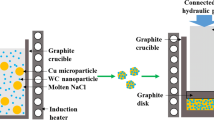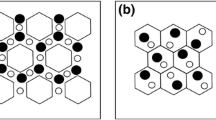Abstract
We here design and fabricate a new kind of copper matrix composites, where titanium carbide nanoparticles are in situ incorporated into and embedded within the copper matrix, by virtue of laser powder-bed-fusion (L-PBF) process. We made a multiscale examination on the microstructures of the additively manufactured samples, unraveling that there are many unusual microstructural features, including grain refinement, the existence of high-density dislocations, and supersaturation of titanium solute atoms in the as-printed metal matrix composites. These unique microstructural features are mainly interpreted by the intense thermal history and the rapid solidification nature of the L-PBF process. The resultant composites then integrate the most important four strengthening mechanisms in metals: grain boundary strengthening, dislocation strengthening, solid solution strengthening, and second-phase strengthening, rendering this new kind of copper matrix composites a remarkably high yield strength (~490 MPa) and large uniform elongation (~12%), surpassing many high-performance copper matrix composites and copper alloys.






Similar content being viewed by others
References
I.A. Ibrahim, F.A. Mohamed, and E.J. Lavernia: Particulate reinforced metal matrix composites—A review. J. Mater. Sci.26, 1137–1156 (1991).
D.B. Miracle: Metal matrix composites—From science to technological significance. Compos. Sci. Technol.65, 2526–2540 (2005).
S.C. Tjong and Z.Y. Ma: Microstructural and mechanical characteristics of in situ metal matrix composites. Mater. Sci. Eng. R Rep.29, 49–113 (2000).
A. Mortensen and J. Llorca: Metal matrix composites. Annu. Rev. Mater. Res.40, 243–270 (2010).
S.I. Cha, K.T. Kim, S.N. Arshad, C.B. Mo, and S.H. Hong: Extraordinary strengthening effect of carbon nanotubes in metal-matrix nanocomposites processed by molecular-level mixing. Adv. Mater.17, 1377–1381 (2005).
J. Hwang, T. Yoon, S.H. Jin, J. Lee, T.S. Kim, S.H. Hong, and S. Jeon: Enhanced mechanical properties of graphene/copper nanocomposites using a molecular-level mixing process. Adv. Mater.25, 6724–6729 (2013).
J. Lin, Z. Li, G. Fan, L. Cao, and D. Zhang: The use of flake powder metallurgy to produce carbon nanotube (CNT)/aluminum composites with a homogenous CNT distribution. Carbon50, 1993–1998 (2012).
Z. Li, Q. Guo, Z. Li, G. Fan, D.B. Xiong, Y. Su, J. Zhang, and D. Zhang: Enhanced mechanical properties of graphene (reduced graphene oxide)/aluminum composites with a bioinspired nanolaminated structure. Nano Lett.15, 8077–8083 (2015).
Z. Li, H. Wang, Q. Guo, Z. Li, D.B. Xiong, Y. Su, H. Gao, X. Li, and D. Zhang: Regain strain-hardening in high-strength metals by nanofiller incorporation at grain boundaries. Nano Lett.18, 6255–6264 (2018).
L.Y. Chen, J.Q. Xu, H. Choi, M. Pozuelo, X. Ma, S. Bhowmick, J.M. Yang, S. Mathaudhu, and X.C. Li: Processing and properties of magnesium containing a dense uniform dispersion of nanoparticles. Nature528, 539–543 (2015).
Z. Liu, Q. Han, and J. Li: Ultrasound assisted in situ technique for the synthesis of particulate reinforced aluminum matrix composites. Compos. B Eng.42, 2080–2084 (2011).
T. Nukami and M.C. Flemings: In situ synthesis of TiC particulate-reinforced aluminum matrix composites. Metall. Mater. Trans. A26, 1877–1884 (1995).
D. Herzog, V. Seyda, E. Wycisk, and C. Emmelmann: Additive manufacturing of metals. Acta Mater.117, 371–392 (2016).
W.E. Frazier: Metal additive manufacturing: A review. J. Mater. Eng. Perform.23, 1917–1928 (2014).
L.E. Murr, S.M. Gaytan, D.A. Ramirez, E. Martinez, J. Hernandez, K.N. Amato, P.W. Shindo, F.R. Medina, and R.B. Wicker: Metal fabrication by additive manufacturing using laser and electron beam melting technologies. J. Mater. Sci. Technol.28, 1–14 (2012).
Y.M. Wang, T. Voisin, J.T. Mckeown, J. Ye, N.P. Calta, Z. Li, Z. Zeng, Y. Zhang, W. Chen, T.T. Roehling, R.T. Ott, M.K. Santala, P.J. Depond, M.J. Matthews, A.V. Hamza, and T. Zhu: Additively manufactured hierarchical stainless steels with high strength and ductility. Nat. Mater.17, 63–71 (2018).
Z. Li, T. Voisin, J.T. McKeown, J. Ye, T. Braun, C. Kamath, W.E. King, and Y.M. Wang: Tensile properties, strain rate sensitivity, and activation volume of additively manufactured 316L stainless steels. Int. J. Plast.120, 395–410 (2019).
W. Li, S. Li, J. Liu, A. Zhang, Y. Zhou, Q. Wei, C. Yan, and Y. Shi: Effect of heat treatment on AlSi10Mg alloy fabricated by selective laser melting: Microstructure evolution, mechanical properties, and fracture mechanism. Mater. Sci. Eng., A663, 116–125 (2016).
M.N. Gussev and K.J. Leonard: In situ SEM–EBSD analysis of plastic deformation mechanisms in neutron-irradiated austenitic steel. J. Nucl. Mater.517, 45–56 (2019).
G.H. Loh, E. Pei, D. Harrison, and M.D. Monzón: An overview of functionally graded additive manufacturing. Addit. Manuf.23, 34–44 (2018).
Y.T. Zhu, J.Y. Huang, J. Gubicza, T. Ungar, Y.M. Wang, E. Ma, and R.Z. Valiev: Nanostructures in Ti processed by severe plastic deformation. J. Mater. Res.18, 1908–1917 (2003).
D. Zhang, D. Qiu, M.A. Gibson, Y. Zheng, H.L. Fraser, D.H. StJohn, and M.A. Easton: Additive manufacturing of ultrafine-grained high-strength titanium alloys. Nature576, 91–95 (2019).
M. Kikuchi, Y. Takada, S. Kiyosue, M. Yoda, M. Woldu, Z. Cai, O. Okuno, and T. Okabe: Mechanical properties and microstructures of cast Ti–Cu alloys. Dent. Mater. J.19, 174–181 (2003).
M. Barmouz and M.K.B. Givi: Fabrication of in situ Cu/SiC composites using multi-pass friction stir processing: Evaluation of microstructural, porosity, mechanical, and electrical behavior. Compos. Appl. Sci. Manuf.42, 1445–1453 (2011).
H. Ferkel: Properties of copper reinforced by laser-generated Al2O3-nanoparticles. Nanostruct. Mater.11, 595–602 (1999).
I.S. Batra, G.K. Dey, U.D. Kulkarni, and S. Banerjee: Microstructure and properties of a Cu–Cr–Zr alloy. J. Nucl. Mater.299, 91–100 (2001).
C.Z. Xu, Q.J. Wang, M.S. Zheng, J.W. Zhu, J.D. Li, M.Q. Huang, Q.M. Jia, and Z.Z. Du: Microstructure and properties of ultra-fine grain Cu–Cr alloy prepared by equal-channel angular pressing. Mater. Sci. Eng., A459, 303–308 (2007).
W. Wang, H. Kang, Z. Chen, Z. Chen, C. Zou, R. Li, G. Yin, and T. Wang: Effects of Cr and Zr additions on microstructure and properties of Cu–Ni–Si alloys. Mater. Sci. Eng., A673, 378–390 (2016).
M. Gholami, J. Vesely, I. Altenberger, H.A. Kuhn, M. Janecek, M. Wollmann, and L. Wagner: Effect of microstructure on mechanical properties of CuNiSi alloys. J. Alloys Compd.696, 201–212 (2017).
Z.J. Zhang, Q.Q. Duan, X.H. An, S.D. Wu, G. Yang, and Z.F. Zhang: Microstructure and mechanical properties of Cu and Cu–Zn alloys produced by equal channel angular pressing. Mater. Sci. Eng., A528, 4259–4267 (2011).
P. Zhang, X.H. An, Z.J. Zhang, S.D. Wu, S.X. Li, Z.F. Zhang, R.B. Figueiredo, N. Gao, and T.G. Langdon: Optimizing strength and ductility of Cu–Zn alloys through severe plastic deformation. Scripta Mater.67, 871–874 (2012).
Acknowledgments
We would like to acknowledge the financial support from the National Natural Science Foundation of China (Grant Nos. 51801120 and 51771111) and the Science & Technology Commission of Shanghai Municipality (Grant No. 17520712400). Shenbao Jin from Nanjing University of Science and Technology is thanked for his kind assistance in APT sample preparation and data analysis.
Author information
Authors and Affiliations
Corresponding author
Rights and permissions
About this article
Cite this article
Ouyang, H., Wang, G., Li, Z. et al. Additively manufactured copper matrix composites: Heterogeneous microstructures and combined strengthening effects. Journal of Materials Research 35, 1913–1921 (2020). https://doi.org/10.1557/jmr.2020.62
Received:
Accepted:
Published:
Issue Date:
DOI: https://doi.org/10.1557/jmr.2020.62




